History. Ancient Urbanisation.
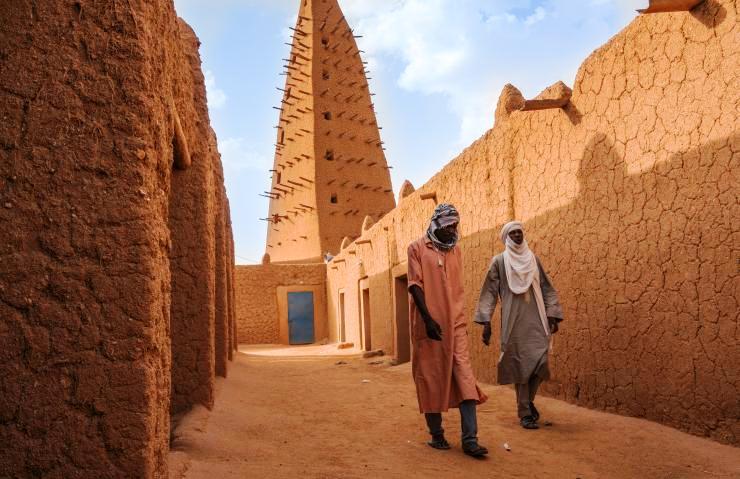
Although colonization contributed to its urban development, Africa had already experienced the flourishing of cities from ancient times. Let us look back at some of these cities through what the continent’s first chroniclers said about them.
The African shore of the Mediterranean is the region in which the most ancient urbanization developed through the work of the Phoenicians, the Carthaginians and the Greeks, to whom Rome subjected and imposed its architectural and decorative canons: Phoenicians: Leptis Magna and Sabratha (Libya); Carthaginians: Kerkuane, Carthage (Tunisia) and Tipasa (Algeria); Greeks: Cyrene, Libya; and others such as Berenice (Benghazi), Adrianapolis (Driana), Tauchira (Toera), Tripoli and Ptolemais (Tolmetta).
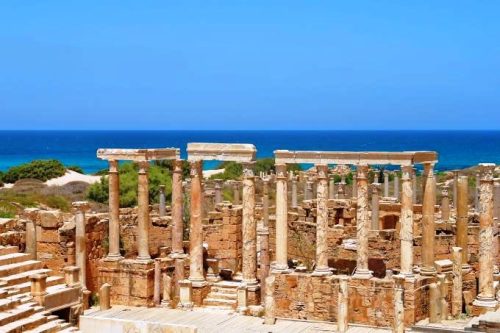
The Theatre at the spectacular ruins of Leptis Magna near Al Khums, Libya. 123rf
The cities were located on a maritime trade route between Alexandria and Carthage whose main product was oil. Rome built cities to colonize or defend – the Algerian Djemila and Timgad – and administer – the Tunisian El Djem and the Moroccan Volubilis and the capital of Mauritania Tingitana. From these emerged a series of inland routes connected with the Saharan caravan routes.
The Cities of the Sahel
They were commercial centres that connected the Mediterranean with tropical Africa, such as Ghadamés, a Berber oasis town in the Nalut District of the Tripolitania region in northwestern Libya, of which Abu l-Hasan al-Bakri – a Muslim hagiographer wrote in The Roads and Kingdoms that it was “A beautiful city, well-watered with a palm grove”. Ualata in Mauritania, with a large market of gold, ivory, slaves, aromatic plants, salt, rubber, copper, tapestries and dates, according to Leo Africanus, whose real name was al-Hasan ibn Muhammad al-Wazzan al-Fasi, traveller, geographer and explorer, author of the Description of Africa.Teghazza, in the far north of Mali, supplied salt to the entire region, and there “Business is done for many hundredweights of gold dust”, wrote Abu Abdullah Muhammad ibn Battutah commonly known as Ibn Battuta, a Maghrebi traveller, explorer and scholar in Through Islam, and said of the Takkeda enclave that “The people have no other work than trade. Every year they go to Egypt, from where they bring back all that is good in cloth and other things. They live in abundance
and in well-being”.
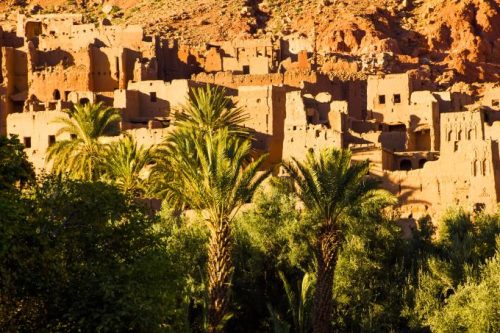
The ancient Moroccan town near Tinghir.123rf
Another geographer, Ibn Hwkal, author of Configuration of the World, wrote of Sijilmasa in Morocco: “Large palm groves, beautiful orchards and gardens can still be seen (…) The inhabitants are generous and cheerful; they distinguish themselves from the peoples of the Maghreb by their external appearance and behaviour. One can see in them the taste for science, modesty and a certain elegance of the body, the practice of virtuous qualities, composure and moderation. The palaces have high and solidly built doors”.
Poetic narrations by same author described other cities in Morocco. Speaking of Agmat he said that “There are all kinds of articles and merchandise”; of An-Nafis that “it is very ancient (…) densely populated and prosperous”; he considered Tamrurt “flirtatious and charming”; Kuga, “the richest in gold of all the countries of the gods”; Tadmekka “the one that most resembles Mecca”; and Uargla “an agglomeration of seven fortified villages”.
The Empires of the Sahel
They were the destination of the caravans. Audaghost in Mauritania was the main gold market. “It is a big city… The people live comfortably and own a lot of goods (…) There are beautiful buildings and very elegant houses (…) Their gold is the best and purest in the world.”
The empire of Ghana arose nearby and the capital, Kumbi Saleh, as Al-Bakri recounted, “is made up of two cities (…) One is inhabited by Muslims, the other is the city of the king”.
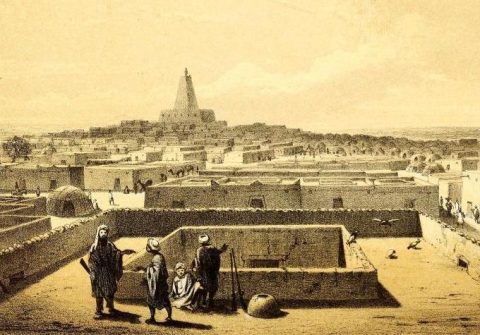
View of Timbuktu. Drawn by Martin Bernatz (1802–1878) after a sketch by Heinrich Barth (1821-1865). The lithograph was produced and printed by M. & N. Hanhart – Barth, Heinrich (1858)
Niani was the capital of the Malian Empire. Ibn Khaldum described it as “Very widespread, very populous and very commercial (…) a stopping place for caravans coming from the Maghreb, Ifriquiya and Egypt. The goods are shipped from all parts”. It was overshadowed by Gao, the capital of the Songhay empire, “One of the most famous in the country of the blacks”, and “Its inhabitants are rich merchants who constantly circulate in the region (…) An infinite number of blacks arrive there with a large quantity of gold to purchase objects imported from Barbary and Europe”, according to the writings of Al-Idrissi, Battuta and Leone Africanus respectively.
The Florentine Benedetto Dei visited Timbuktu in 1470 and said: “A lot of business is done selling thick fabrics, twills and cloth.” A century later, Leo Africanus indicated a turning point in business: “Many manuscript books are sold that come from Barbary. There is more profit from this sale than from all other commodities.”
At the end of the 16th century, in his work Tarik el-Fettach, Al Hajj Mahmud Kati (or Mahmoud Kati) an African Muslim Songhai scholar, warned that “Timbuktu had no rivals among the cities of the blacks (…) for the solidity of its institutions, political liberties, purity of customs, safety of persons and property, clemency and compassion for the poor and foreigners, and consideration for students and men of science”.
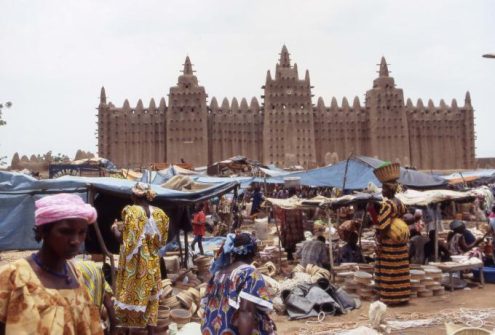
Great Mosque of Djenné. The city re-emerged in the 19th century as a cosmopolitan and prosperous city. Photo: Andrea Caruccio.
D’Jenne in Mali re-emerged in the 19th century as a cosmopolitan and prosperous city, and by the mid-12th century it was, for Al-Sadi, “A great fortunate and blessed city (…) It is one of the great markets for Muslims”. The French explorer René Caillié confirmed this in the early 19th century: “Every day numerous caravans and merchants arrive carrying all sorts of useful supplies.”
It was the capital of the Bambara kingdom of the same name, which emerged after the dissolution of Songhay. Mungo Park, a Scottish explorer, in the eighteenth century, recognized that “The sight of this sprawling city, the numerous canoes on the river, the lively population, and the crops of the surrounding fields, formed a whole picture of civilization of grandeur, such as I did not expect to find in Africa”.
Bambara city-states such as Zaria, Zanfara, Gobir and Sokoto were urban centres with a thriving life. Katsena and Kano stood out. Leo Africanus said of its inhabitants that they were “Skilled artisans and rich merchants”. Heinrich Barth, a German explorer, was there in the 19th century and underlined the production of its kinds of cotton: “I could estimate the total production of this industry at its minimum export at around 300,000 million Kurds (…) With 50-60,000 Kurds, a family can live comfortably with all expenses included.”
The Cities of East Africa
Kush, an ancient kingdom in Nubia, had three capitals – Kerma, Napata and Meroe – which reflected a culture derived from that of Egypt. In Christian Nubia, Soba, Dongola and Faras were capitals of kingdoms.
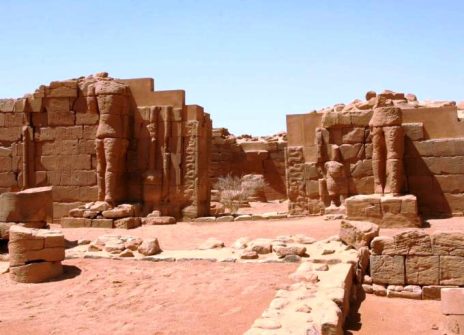
Nubian temples. Entrance to Great Enclosure, Musawwarat es-Sufra. CC BY-SA 3.0/COSV
Soba, as documented by Al-Maqrīzī a medieval Egyptian historian, had “Very beautiful buildings, large convents, churches, where gold abounds”, while Dongola was, “Very populated”, the inhabitants “are rich and civilized because they trade with Cairo and with all the cities of Egypt.”On the coast, Mogadishu produced “fabrics that are incomparable; they export most of them to Egypt and elsewhere”; Zayla, “A vast city with a large souk”, while in Kilua “Ivory is almost always given away and gold is very rarely given”, wrote Ibn Battuta.
In the Gulf of Guinea
Begho and Bono Manso (in present-day Ghana) were two important gold trading markets where trade between the interior and the coast was frequent. Kumasi was the capital of all the Akan, while the Yoruba organized themselves into city-states. Ifé was the origin of them all and their spiritual and cultural centre. Oyo was the most powerful, and Benin the best known. Already in the 17th century, Dutch geographer Olfert Dapper in his Description of Africa, said that “It is composed of 30 very straight streets (…) as well as an infinity of small transverse streets.
The houses are close to each other and aligned in good order with roofs and balustrades”.
Cities of the Centre-South
The historical capital of the Mbanza Congo kingdom, renamed São Salvador, was connected to the coast by a wide road. Antonio Pigafetta, navigator, geographer and citizen writer of the Republic of Venice, wrote in his Relación del Reino del Congo: “It was Don Alfonso (…) who surrounded it with walls (…) He did the same with his palace and the royal quarters, leaving in the centre of these enclosures a large open space where the main church was built. Outside the walls there are numerous buildings belonging to the lords, without order, so they can live near the court”.
Further south, Luanda was built in 1575, where shells were used for trade. In his Description of Angola, Abreu de Brito recalled that” one day, while I was in the city, a large quantity of gold coins was sent to the Congo for the purchase of slaves; It was rejected by the sellers. They said that their true currency, their gold, were the shells of Luanda, which were the ones with which they got rich”.
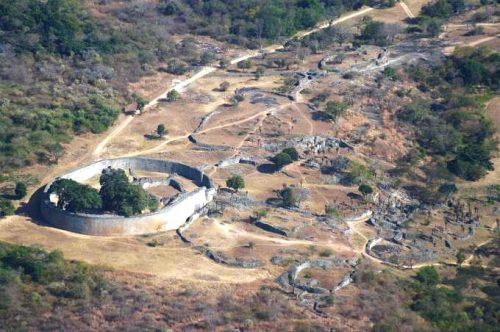
Aerial view of Great Zimbabwe’s Great Enclosure (circumference 250 m, maximum height 11 m)[1] and adjacent ruins looking southeast from the Hill Fort. CC BY-SA 4.0/ Janice Bell
José Luis Cortés López



